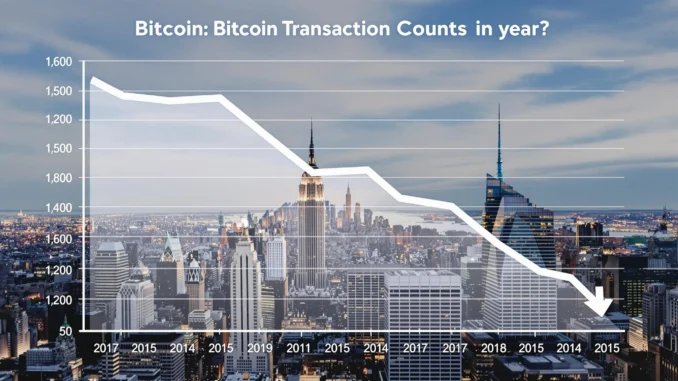
Is Bitcoin losing its buzz? Recent data reveals a startling trend in the Bitcoin network: transaction activity is hitting levels not seen in a year. Specifically, the 7-day moving average of Bitcoin transactions has plummeted to 330,000. That’s a significant 55% decrease from its peak. What’s behind this dramatic dip in BTC transaction count, and what does it signal for the future of the leading cryptocurrency? Let’s dive deep into the numbers and explore the potential implications for investors and the broader crypto ecosystem.
Why Are Bitcoin Transactions Declining?
Several factors could be contributing to this noticeable decrease in crypto transactions on the Bitcoin network. It’s not just a simple fluctuation; a 55% drop is a substantial shift that warrants closer examination. Here are a few potential reasons:
- Market Sentiment Shift: The overall sentiment in the cryptocurrency market can heavily influence on-chain activity. Periods of market uncertainty or bearish trends might lead to reduced trading and fewer transactions as investors become more cautious.
- Layer-2 Solutions Adoption: Solutions like the Lightning Network are designed to handle smaller, faster, and cheaper Bitcoin transactions off the main chain. Increased adoption of these Layer-2 solutions could naturally lead to a decrease in on-chain blockchain activity. Users are opting for quicker and more cost-effective methods for everyday transactions.
- Reduced Retail Interest: After periods of heightened hype and retail investor frenzy, a cooling-off period is common. If fewer new users are entering the Bitcoin space or existing users are holding rather than transacting, transaction counts will inevitably fall.
- Economic Factors: Broader economic conditions, such as inflation or recessionary fears, can impact investment and spending habits, potentially affecting transaction volumes across various asset classes, including cryptocurrencies.
- Network Congestion Relief: Ironically, periods of lower transaction counts can also indicate that the Bitcoin network is less congested. While high transaction counts can signify popularity, they can also lead to higher fees and slower processing times. A decrease might suggest a more efficient network, though the current drop is significant enough to warrant concern beyond just congestion relief.
Decoding the Numbers: What Does a 55% Drop in BTC Transaction Count Really Mean?
To truly understand the significance of this 55% decline in BTC transaction count, let’s break down what these numbers represent and why they matter:
| Metric | Current Value (7-day avg) | Previous Peak (All-time) | Decline |
|---|---|---|---|
| 7-day Average Transaction Count | 330,000 | 730,000 | 55% |
This table clearly illustrates the magnitude of the drop. A 55% decrease isn’t just a minor dip; it’s a substantial contraction in network usage as measured by transaction volume. Here’s why this is important:
- Network Health Indicator: Transaction count is often viewed as a key indicator of the overall health and activity of the Bitcoin network. A sustained decrease can signal reduced user engagement or a shift in how Bitcoin is being used.
- Potential Price Implications: While not a direct correlation, some analysts believe that decreased on-chain activity can sometimes precede or coincide with price corrections. Lower transaction volume might suggest less demand or speculative interest in Bitcoin at the current moment.
- Miner Revenue Considerations: While transaction fees are not the primary source of revenue for Bitcoin miners (block rewards are), a significant drop in transactions could, over time, impact miner revenue if sustained. However, the current impact is likely minimal compared to block rewards.
- Adoption Narrative: For those who view transaction count as a measure of adoption, a decrease might be interpreted negatively. It could raise questions about Bitcoin’s real-world utility as a medium of exchange if on-chain transactions are consistently declining.
Is This a Cause for Alarm or Just a Natural Cycle in Blockchain Activity?
The crucial question is whether this drop in blockchain activity is a temporary fluctuation or a sign of a more concerning trend. It’s important to consider both possibilities:
Potential Concerns:
- Sustained Downtrend: If the decline continues and transaction counts remain low for an extended period, it could indicate a deeper issue, such as waning interest or a fundamental shift in user behavior away from on-chain Bitcoin transactions.
- Market Bearishness: As mentioned earlier, reduced transaction activity can sometimes be a symptom of a broader bearish market sentiment. If this is the case, it could foreshadow further price corrections or a prolonged period of market stagnation.
Reasons for Optimism or Nuance:
- Layer-2 Success: If the decline is primarily driven by the successful adoption of Layer-2 solutions like Lightning Network, it might actually be a positive development. It would indicate that Bitcoin is scaling and evolving to handle different types of transactions more efficiently, even if those transactions are not all visible on the main chain.
- Hodling Culture: Bitcoin is increasingly viewed as a store of value. A decrease in transaction counts could simply reflect a growing “hodling” culture, where users are accumulating and holding Bitcoin for long-term investment rather than frequently transacting with it. This is not necessarily negative; it’s just a different use case.
- Cyclical Nature: Cryptocurrency markets are known for their cyclical nature. Periods of high activity are often followed by periods of consolidation or reduced activity. This could simply be part of a natural market cycle.
Actionable Insights: What Should Crypto Enthusiasts and Investors Do?
So, what should you, as a crypto enthusiast or investor, take away from this news about declining Bitcoin transactions? Here are some actionable insights:
- Monitor On-Chain Metrics: Stay informed about on-chain metrics like transaction counts, active addresses, and transaction volume. These data points can provide valuable insights into the health and activity of the Bitcoin network and the broader crypto market.
- Consider Layer-2 Solutions: Explore and understand Layer-2 solutions like the Lightning Network. These technologies are crucial for Bitcoin’s scalability and can offer faster and cheaper transaction options.
- Diversify Your Research: Don’t rely solely on transaction counts as your only indicator of Bitcoin’s health. Look at a range of metrics, including developer activity, network upgrades, institutional adoption, and regulatory developments, to get a more holistic picture.
- Stay Informed About Market Sentiment: Keep abreast of the overall market sentiment and macroeconomic factors that could be influencing crypto markets. Market conditions play a significant role in on-chain activity.
- Long-Term Perspective: Remember that cryptocurrency markets are volatile and cyclical. Focus on the long-term fundamentals and adoption trends rather than getting overly fixated on short-term fluctuations in metrics like transaction counts.
Conclusion: Navigating the Evolving Landscape of Bitcoin
The drop in Bitcoin’s 7-day average transaction count to a 12-month low is undoubtedly a noteworthy development. While it might raise some eyebrows and spark concerns about network activity, it’s crucial to analyze this trend within a broader context. Factors like Layer-2 adoption, evolving user behavior, and market cycles all play a role. By staying informed, monitoring key metrics, and maintaining a long-term perspective, you can navigate the ever-changing landscape of Bitcoin and the cryptocurrency world with greater confidence. The key takeaway? Don’t panic, but definitely pay attention. The story of Bitcoin and its on-chain activity is still unfolding, and understanding these fluctuations is vital for making informed decisions in the crypto space.




Be the first to comment